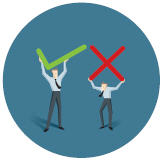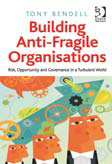Am I Learning from the Failure of Others?
By Professor Tony Bendell, MD and Lead Trainer, Anti-Fragility Academy
 All leaders know there’s a lot to be said for the old adage, “Good judgment comes from experience, but experience comes from bad judgment.” Conventional wisdom says it’s not strictly true, of course. You don’t have to have gotten something wrong for the world to deliver you — and your company — a crushing blow. It just takes overlooking the possibility, however slight, that something may happen that could impact your company.
All leaders know there’s a lot to be said for the old adage, “Good judgment comes from experience, but experience comes from bad judgment.” Conventional wisdom says it’s not strictly true, of course. You don’t have to have gotten something wrong for the world to deliver you — and your company — a crushing blow. It just takes overlooking the possibility, however slight, that something may happen that could impact your company.
What is worse is that we now live in a world of rare, hard-to-predict events of monumental consequences, such as the financial crisis. Such events are almost ignored by our conventional risk analyses, since these don’t account for everything you cannot conceive of. When chaos happens these days, it’s often a new type of chaos. And it’s happening with increasing frequency, diversity, and impact.
 So, what to do? Doing nothing is not an option. Shareholders and stakeholders rightly expect more, or at least hold leaders accountable when the unpredictable happens. Not everyone gets a second chance anymore. A reasonable start is to look at the failures of others, but that alone is far from enough.
So, what to do? Doing nothing is not an option. Shareholders and stakeholders rightly expect more, or at least hold leaders accountable when the unpredictable happens. Not everyone gets a second chance anymore. A reasonable start is to look at the failures of others, but that alone is far from enough.
MAKING YOUR COMPANY ANTI-FRAGILE
What we need to do is make our companies “anti-fragile.” No, this is not just a new word for robust; Nassim Taleb published a seminal book on the subject in November 2012.
The difference between anti-fragile and robust is that the robust (e.g., company) is just waiting for a big enough wave to overpower it, since you can never be sure you are robust enough. In contrast, the anti-fragile gets stronger with every wave, stress, and shock. To a very large extent, I’m anti-fragile; I get stronger by exercising. So, how should you do the same for your company?
First, you probably need to do a fragility audit. Remember that, frequently, the more efficient your systems, the more fragile they are. Then, consider mechanisms for enhancing anti-fragility within your governance, strategy, people/culture, processes/operations, technology, supply chain, and other key dimensions of your organization.
 Making each of these dimensions antifragile is potentially a real challenge, since you often need to borrow from existing good approaches while steering clear of a lot of bad management doctrine peddled by consultants and the business schools.
Making each of these dimensions antifragile is potentially a real challenge, since you often need to borrow from existing good approaches while steering clear of a lot of bad management doctrine peddled by consultants and the business schools.
Anti-fragility is about learning, development, and growth — not about the corporation forgetting to think or suffering from bad governance, as so often happens in large organizations. The world is a dangerous place, and it’s time to take stock.
